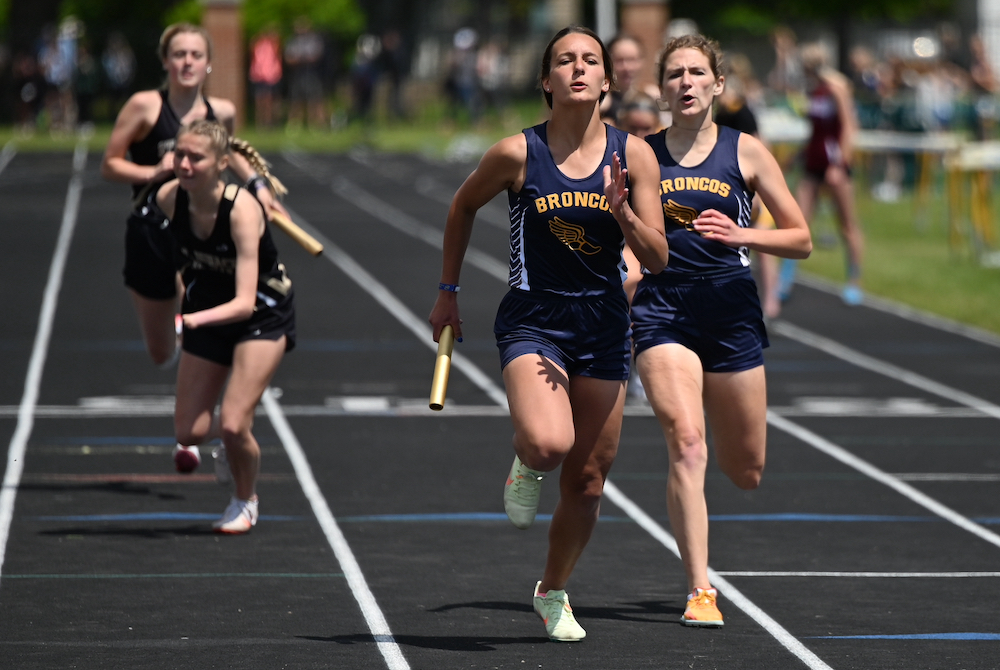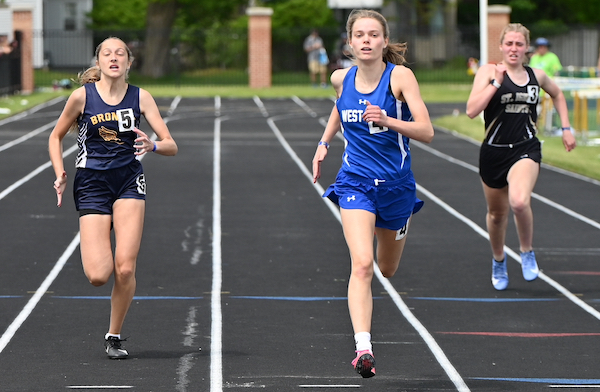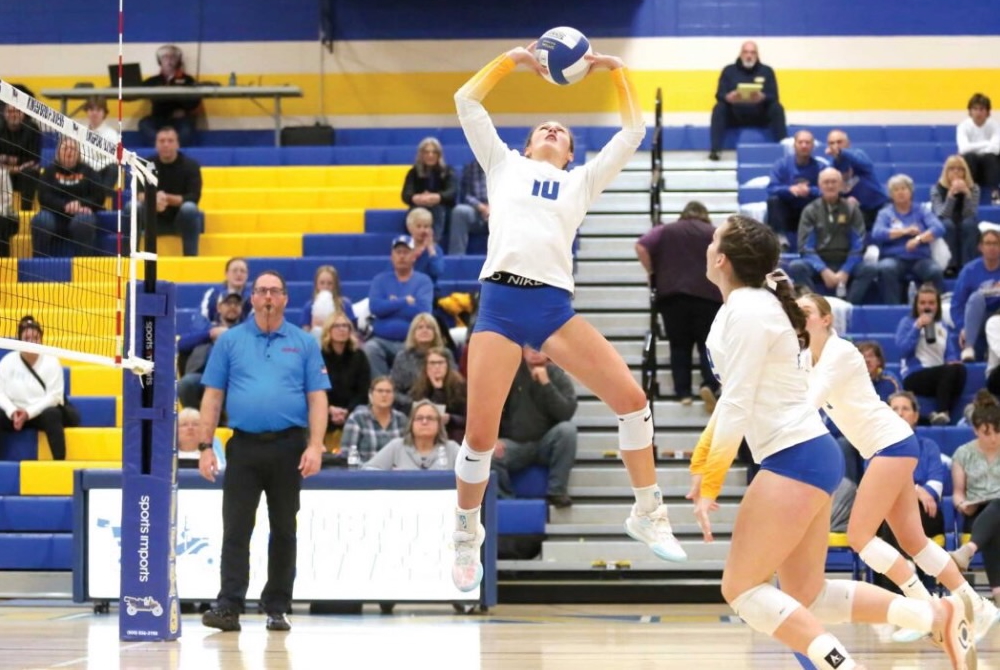
Bark River-Harris Grows Team, Gains 1st Girls Track & Field Finals Title
By
John Vrancic
Special for MHSAA.com
June 5, 2022
KINGSFORD — The Bark River-Harris girls made a statement here Saturday while earning the first Upper Peninsula track & field title in their school’s history.
BR-H, which topped the Division 2 standings with 107 points, was followed by West Iron County with 74 and Ishpeming at 60.
“This is a very big moment,” said BR-H coach Jason Lockwood. “This is something our upperclassmen started talking about at the end of last season. Last year we came here with a small team and got third. The bigger numbers this year were a major factor. We’re very strong in the sprints and sprint relays. Having that depth really helps.”
The Broncos won the 800-meter relay in a school-record 1 minute, 50.95 seconds, and freshman Julia Olson set a school record (1:01.25) while placing third in the 400.
Sophomore Mckenzie Hoffmeyer won long jump (16-1¾) for the second-straight year and took second in the 100 (13.04) and 200 (27.14). Senior Alaska Peterson added a third in the long jump (14-5½).
 Carley Varoni added a first in pole vault (8-0), and senior Aspen Fredrick gained her first U.P. 300 hurdles title at 53.57.
Carley Varoni added a first in pole vault (8-0), and senior Aspen Fredrick gained her first U.P. 300 hurdles title at 53.57.
“I had confidence in my ability to jump over the hurdles,” said Fredrick. “This is only my sixth time doing this and my first individual title. That’s what I was thinking (during the race), and that’s what kept me going.”
West Iron’s Danica Shamion repeated as champion in the 100 (12.7), 200 (26.82) and 400 (58.77), and Ishpeming sophomore Lola Korpi retained her 800 (2:36.11), 1,600 (5:42.11) and 3,200 (12:34.95) titles.
“The 1,600 went well,” she said. “I just wanted to stay in front and get as many points for our team as I could. I tried to work on picking up the pace in the second and third laps.”
In the 3,200 (which combined the D-1 and D-2 runners competing at the same time), Houghton senior Ingrid Seagren led the entire race until the final home stretch when she dropped to third overall.
“I was just planning on staying with the group I was with, and when I saw she was getting tired, I thought there was a chance,” Korpi said. “I’m proud of Ingrid, and our team for taking third place. Third is good, especially for the numbers we have.”
Iron Mountain’s Chloe Maycroft retained her high jump crown (4-11), and Manistique sophomore Danielle Lund took first in shot put (33-2) and second in discus (95-0).
Gwinn’s Lena Pleaugh and Jordana Hardy went 1-2 in the 100 hurdles in 17.77 and 18.18, respectively.
Manistique won the 1,600 relay (4:23.84) and 3,200 (10:43.63).
“Today we had little bit of a rough handoff for three and four, but found a way to overcome that,” said Emeralds junior Kelsey Muth. “We’re just .3 second away from our school record in the 1,600 relay, which I think will give us motivation for next year. This is the first time all year we’ve won both the 1,600 and 3,200 relays. This is a real good way to wrap up the season.”
PHOTOS (Top) On the way to winning the 800 relay, Bark River-Harris's Aspen Frederick hands off to teammate Julia Olson. Other members of the winning relay team were Mckenzie Hoffmeyer and Lauren Zwanda. (Middle) West Iron County's Danica Shamion, middle, wins the 200. Hoffmeyer, left, took second. (Click for more from Cara Kamps/Run Michigan.)

Kingsford's Kreider Prepared for Next Level After Finishing Stellar Flivvers Career
By
John Vrancic
Special for MHSAA.com
June 19, 2025
KINGSFORD — After completing a successful high school volleyball career, Maddy Kreider is ready to take the next step.
 The Kingsford senior is taking her talents to Michigan Tech, where she’s expected to continue primarily as a setter.
The Kingsford senior is taking her talents to Michigan Tech, where she’s expected to continue primarily as a setter.
“That will be a big step for sure, but it’ll be exciting being with the girls,” she said. “The girls are taller in college. It will definitely be an adjustment, physically and mentally. We’ll be traveling longer distances, and it’ll be a matter of improving the mental part of my game.”
Kreider was selected the Upper Peninsula’s Defensive Player of the Year her final two seasons after the U.P. Sportswriters and Sportscasters Association began voting for all-U.P. volleyball.
“That’s quite an accomplishment,” she said. “It’s a real honor playing with girls I grew up with. We had a great season.”
The 5-foot-8 setter was a four-year starter and two-year team captain at Kingsford, leading the Flivvers to three Division 2 District titles and back-to-back undefeated Great Northern Conference championships. She twice was named GNC Player of the Year.
She was also selected all-state first team in the fall and all-state second team in 2023, and all-region throughout her prep career. Her serving percentage also topped .900 throughout her four seasons on varsity.
 Last fall, the Flivvers reached the Regional Semifinal at Manistique where they dropped a 3-2 decision to Kingsley.
Last fall, the Flivvers reached the Regional Semifinal at Manistique where they dropped a 3-2 decision to Kingsley.
“I thought we’d get through,” Kreider said. “We came out lights out in the first two sets, then it was close in the last three.”
Also among the team’s highlights this past fall was a victory at Calumet, approximately 2½ weeks after dropping a 3-1 decision to the Copper Kings on Kingsford’s home floor.
“We wanted to play them,” Kreider said. “They’re a great bunch of girls to play against. They’ve been the measuring stick up here for many years. Winning on their floor was super exciting. We knew we had to play well just to be competitive. That was a great confidence builder for our group. We were definitely on a high going into the District.”
The Flivvers opened their postseason with a 3-1 triumph over Houghton, then defeated Escanaba in straight sets in the District Final.
Kreider will join Calumet senior Maddie Torola at MTU this fall. Torola, who recorded a season-high 19 kills in the four-set victory at Kingsford, helped the Copper Kings finish 29-5 and reach the Division 3 Regional Final at Sault Ste. Marie where they dropped a 3-2 decision to Traverse City St. Francis.
“It was fun playing against her in high school,” Kreider said. “It will be even more fun playing as teammates. It’ll be exciting to be playing on the same team.”
Both will be playing under new head coach Cindy Pindral at Tech. Both of Kreider’s parents played for the Huskies, her mother (and Kingsford varsity coach) Jaclynn volleyball from 1998-2002 and her father Jason basketball from 1997-2000.
Maddy Kreider recently earned an additional honor when she was selected Female Athlete of the Year for Kingsford’s Class of 2025. She recently completed a solid track & field season for the Flivvers.
At the U.P. Division 1 Finals, Kreider placed fourth in the 100-meter dash (13.2) and anchored the Flivvers to a third-place finish in the 800 relay (1:51.57) and fourth in the 400 (53.03) on their home track.
Kreider was named one of 32 MHSAA/Farm Bureau Insurance Scholar-Athlete Award winners this winter and plans to study exercise science and kinesiology at MTU.
 John Vrancic has covered high school sports in the Upper Peninsula since joining the Escanaba Daily Press staff in 1985. He is known most prominently across the peninsula for his extensive coverage of cross country and track & field that frequently appears in newspapers from the Wisconsin border to Lake Huron. He received the James Trethewey Award for Distinguished Service in 2015 from the Upper Peninsula Sportswriters and Sportscasters Association.
John Vrancic has covered high school sports in the Upper Peninsula since joining the Escanaba Daily Press staff in 1985. He is known most prominently across the peninsula for his extensive coverage of cross country and track & field that frequently appears in newspapers from the Wisconsin border to Lake Huron. He received the James Trethewey Award for Distinguished Service in 2015 from the Upper Peninsula Sportswriters and Sportscasters Association.
PHOTOS (Top) Kingsford’s Maddy Kreider sets for her teammates during a match last season. (Middle) Kreider, right, takes a photo with Kingsford’s Male Athlete of the Year Gavin Grondin. (Photos provided by the Kingsford athletic department.)

